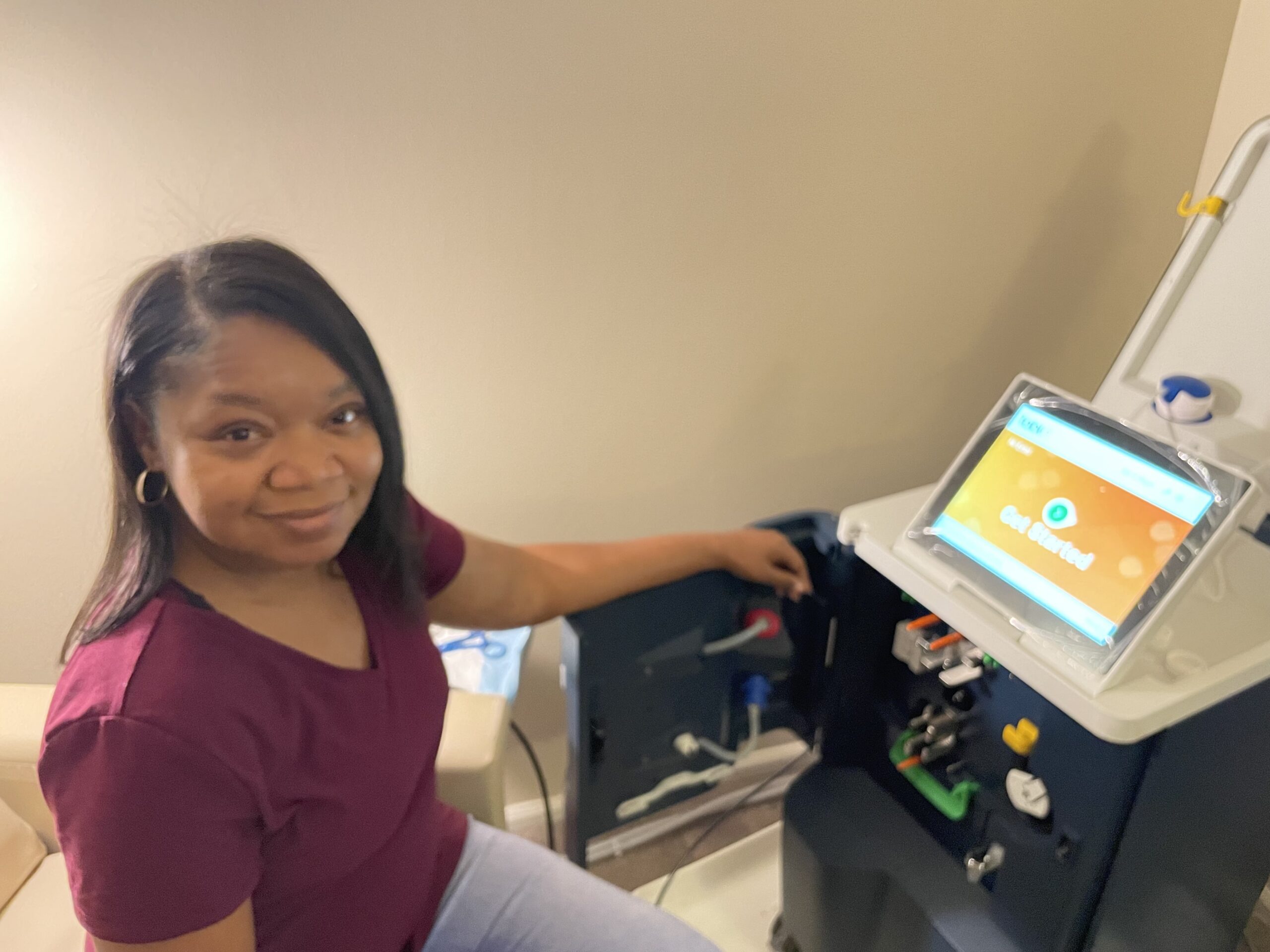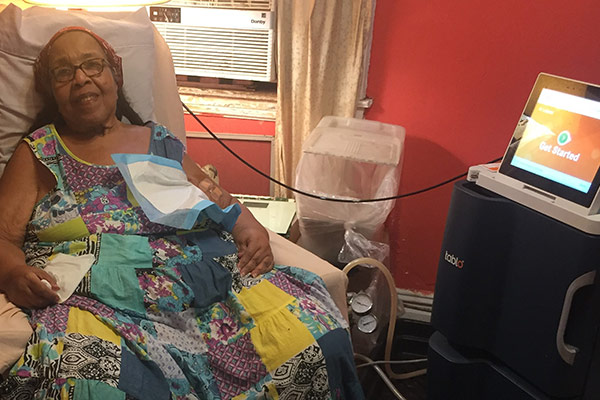Diabetic Kidney Disease Patient Erin Lives Authentically on Home Dialysis

Summary
Erin, a special education teacher and diabetic kidney disease patient, has experienced every dialysis modality, in every setting, over the past 14 years. She is now feeling in control of her kidney health and quality of life with Tablo at home.
Erin and her husband live in Ohio, where she teaches young children with learning disabilities. She enjoys coming up with creative ways to help her students learn, rather than focusing on her own health issues. Erin’s difficult journey has included diabetes, a kidney and pancreas transplant, and every type of dialysis and vascular access. Since May of this year, she has been feeling in control of her kidney disease and schedule, after starting on home hemodialysis (HHD) with the Tablo® Hemodialysis System.
Now 35, Erin was diagnosed with Type 1 diabetes at age six, that later contributed to a kidney failure diagnosis at 21. She discovered that her kidney function was declining when she went to the doctor for a sinus infection. “The doctor said, while you’re here let’s do some labs just to check everything. The results came back, and I was at 50% kidney function. It was very unexpected, and just spiraled from there,” says Erin.
A year later, as her diabetic kidney disease progressed into end-stage renal disease (ESRD), she underwent arteriovenous fistula surgery in preparation for dialysis. But the fistula didn’t mature in time, so she needed to have a chest port placed to start in-center hemodialysis.
She had just graduated college, was working part time and spending three evenings a week at the dialysis clinic. “It was a hustle to get there on time after work. I also felt drained and ill, it was rough,” she says.
Only six months later, Erin was surprised to get a call from the transplant center where she had been waitlisted for both a kidney and a pancreas. “I was fortunate that in June 2012, my parents took me directly from dialysis to the hospital where I had a successful deceased donor kidney and pancreas transplant,” she says. “I was excited but also felt a lot of sadness, because while my family was celebrating my new gift of life, someone else’s family was grieving and mourning.”
Simultaneous Kidney-Pancreas Transplantation Quick Facts
- A kidney-pancreas transplant is an operation to place both a kidney and a pancreas, at the same time, into someone who has kidney failure related to type 1 diabetes.
- In 2015, about 700 were done at transplant centers in the U.S.
- The national average for survival rates in adults is 95% are functioning well one year after the operation, and 92.5% at three years.
Source: National Kidney Foundation
Following her surgery and recovery, Erin was amazed to be able to enjoy a whole new world of freedom from insulin and dialysis. She started working two jobs while looking for a full-time teaching position. “Most of my life I had been diabetic, so to not have to monitor my blood sugar or take insulin was amazing,” she describes.
Then, six years later, in 2018, Erin’s kidney transplant began failing. “It was a long rejection. Lots of hospitalizations, infusions and treatments to try to save it as long as we could. But eventually, I ended up back in-center on dialysis,” she says.
A Switch to PD
Erin’s nephrologist then found that her fistula didn’t have a thrill (also called a pulse or vibration) and it was unusable. She had to decide whether to get a fistula in her other arm, that she didn’t want to do, or go on peritoneal dialysis (PD). Erin chose PD, and underwent surgery to have an abdominal catheter implanted. HHD had not yet been offered as an option to her.
Erin’s PD experience was quite different from what she expected. “They had said, you hook up to the machine at night, wake up in the morning, disconnect and go on about your day,” she says.
In reality, Erin had to connect to the PD machine for nine hours a night, seven days a week. “I was what they called a low transporter [in some patients, waste toxins pass more slowly from the bloodstream and into the dialysis fluid]. Once the fluid came out in the morning, I had to carry two liters of fluid in my abdomen all day, which was very uncomfortable. I drained it after work, then put more in for a couple of hours before it was time to hook up again for a nine-hour session,” she says.
Diabetes and Chronic Kidney Disease Quick Facts
- Over time, high blood sugar from diabetes can damage blood vessels in the kidneys so they don’t work as well as they should.
- Diabetes is the leading cause of kidney failure, accounting for 44% percent of new cases.
- More than 35% of people aged 20 years or older with diabetes have CKD.
Sources: Centers for Disease Control and Prevention and National Kidney Foundation
Transition to Home Hemodialysis
For the next year, Erin’s life was consumed with PD. Then in early 2019, her transplanted pancreas failed, leading to life-threatening diabetic ketoacidosis and she was in a coma for eight days.
Following that hospital stay, Erin was back to being a Type 1 diabetic. She also decided to go back to hemodialysis for her ESRD. A vascular surgeon suggested she get a graft in her non-dominant left arm, the same arm where the fistula was. She agreed, underwent her third vascular access surgery and went back in-center, to the old dialysis machines she used to be on. She also had the PD catheter removed.
Erin’s team then introduced her to another home dialysis option, the NxStage system, the only HHD machine available as of 2019. With her PD experience under her belt, she and her mother started the training. “After a week of training, I told my doctor, ‘I don’t think this is for me,’” says Erin. “It was intimidating. I wasn’t up for five to six weeks of training with my full-time job, and so I decided to go back in-center.”
In November 2019, she returned to the dialysis clinic, on third shift as she had done seven years ago. And this time around, she was working full time as a teacher. “It was very stressful, and I was exhausted. Once I released my students for the day, I would put numbing cream on my arm and then rush to my 4:00 chair time on Monday, Wednesday and Friday,” she continues.
Pandemic and a Dialysate Disaster
When the pandemic hit, Erin started receiving notifications from her clinic that she and other patients had been exposed to COVID. She was scared, as she sat so close to other patients during treatment, and decided to try HHD again. That summer, she and her mother restarted the NxStage training.
“The most intimidating part was learning how to put the needles in, but once I got it, it wasn’t as bad as I thought,” says Erin. “It was discouraging though that my runtime was four hours, four days a week, versus three hours and 15 minutes, three days a week in-center.” Her nephrologist explained that more dialysis can help keep her healthy, and home hemo is a good option for that. But, there was a lot more for her to contend with than just the longer treatment time.
NxStage setup took time, and making batches of dialysate was a time-intensive ordeal, every three days. “I would start the batch in the morning before going to work. The supplies were also heavy and overwhelming. I even had them stored under the bed in our apartment,” she says. She also attempted to travel with the system on a family road trip. “Our SUV trunk was full of dialysate bags and other supplies, with no room for our luggage. I spilled fluid all over the hotel room, it was not a good situation. I would never do it again.”
Added to this, in summer 2021 Erin developed osteomyelitis, a painful bacterial bone infection, in her femur, requiring several surgeries and hospital stays. After she was released, she went back to in-center dialysis as she could no longer handle the heavy dialysate bags at home.
An Instagram Discovery
Around this same time, Erin started posting about her health journey on Instagram, calling her account “Authentically_Erin_,” as she wanted to authentically share her experiences. One day while browsing on the platform, she came across the Tablo® Hemodialysis System. She was very intrigued by the technology, watched videos on Instagram and YouTube, and reached out to Outset Medical. She found out that a center near her had just started training patients to go home on Tablo.
“It all worked out perfectly. I switched to a nephrologist at that center and started training in May of this year,” she says. She completed the training easily, and started on Tablo at home soon after.

“Tablo shows you on the screen exactly what to do,” says Erin. “I’ve named my machine Linda, and she doesn’t let me skip anything. It’s so easy to set up too.”
Erin treats on Tablo at home every other day for three hours—the least amount of time she’s ever had to sit for dialysis—and on her own schedule. She usually comes home from work, has dinner with her husband and rests, then does her treatments in the evenings before bed. “I like that I have the flexibility to adjust my schedule if I have to stay late at work, or if other things come up,” she says. “My husband or mom can assist me with treatment, set up or takedown if needed also.” Erin also transitioned to an insulin pump device to help manage her diabetes.
As she has experienced every type of dialysis in every setting, Erin says that one stands above the rest. “I would absolutely recommend Tablo at home. I am so appreciative and thankful for Tablo and Outset for finally looking at dialysis and saying what can we do to make this better, because it’s been so archaic.”
Image at the top of this page: Erin and her then-fiancée Darrell during their engagement photo shoot at Lake Erie, OH.
Interested in home dialysis with Tablo?
The Tablo Hemodialysis System is available for use both in-center and at home, through your provider. We may use the information you enter to reach out to your provider or other providers in your area, to let them know that you are interested in Tablo. By filling out this form and providing us your information, you agree to our Privacy Policy.
* Tablo Hemodialysis System Disclaimer:
Results may vary. Keep in mind that all treatment and outcome results are specific to the individual patient. Please consult your physician for a complete list of indications, warnings, precautions, adverse events, clinical results, and other important medical information. It is important that you discuss the potential risks, complications, and benefits of this product with your doctor prior to receiving treatment, and that you rely on your physician’s judgment. Only your doctor can determine whether you are a suitable candidate for this treatment.

